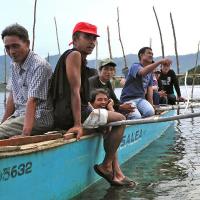Marine Life Encyclopedia
Least Storm Petrel
Halocyptena Microsoma
Distribution
Tropical to warm temperate latitudes of the eastern Pacific Ocean
ECOSYSTEM/HABITAT
Nest on rocky shores; feed in open ocean (pelagic)
FEEDING HABITS
Foraging predator
TAXONOMY
Order Procellariiformes (albatrosses, petrels, and relatives), Family Hydrobatidae (storm petrels)
Least storm petrels are excellent fliers and are known for their behavior of “dancing” along the sea surface, hunting for small pelagic prey. They primarily eat small crustaceans and other plankton and feed by scooping up their prey without landing on the water or getting their feathers wet. In this manner, they look like they are walking on water. Least storm petrels spend the majority of their time at sea, on the wing, and rarely rest. Their open ocean feeding grounds extend as far south as Peru. Like all petrels, least storm petrels drink seawater and have a specialized gland on their upper beaks used to excrete salt, preventing them from becoming dehydrated.
Like all seabirds, least storm petrels nest on land. All individuals of this species return to islands in the Gulf of California, each year, to nest in large colonies. They reproduce via internal fertilization, and females lay fertilized eggs in small cracks along rocky shores. Males and females both care for the eggs and chicks. Though least storm petrels have few natural predators at sea or on land, they are susceptible to predation by invasive cats, rats, or dogs when nesting.
Least storm petrels are quite common and are currently a species of least conservation concern. Populations are decreasing, however, and like all seabirds in the Gulf of California, they may be threatened by changing food webs in that basin.
Engage Youth with Sailors for the Sea
Oceana joined forces with Sailors for the Sea, an ocean conservation organization dedicated to educating and engaging the world’s boating community. Sailors for the Sea developed the KELP (Kids Environmental Lesson Plans) program to create the next generation of ocean stewards. Click here or below to download hands-on marine science activities for kids.
Additional Resources:
Get Involved
Donate Today
SUPPORT OUR WORK TO PROTECT THE OCEANS BY GIVING TODAY
With the support of more than 1 million activists like you, we have already protected nearly 4 million square miles of ocean.
TAKE ACTION NOW
Support policy change for the oceans
Decision-makers need to hear from ocean lovers like you. Make your voice heard!
VISIT OUR ADOPTION CENTER
SYMBOLICALLY ADOPT AN ANIMAL TODAY
Visit our online store to see all the ocean animals you can symbolically adopt, either for yourself or as a gift for someone else.
DOWNLOAD OCEAN ACTIVITIES
HELP KIDS DISCOVER OUR BLUE PLANET
Our free KELP (Kids Environmental Lesson Plans) empower children to learn about and protect our oceans!




